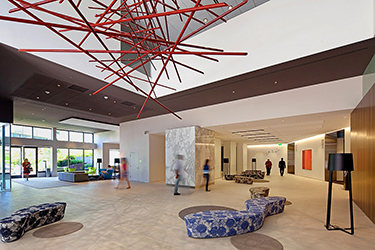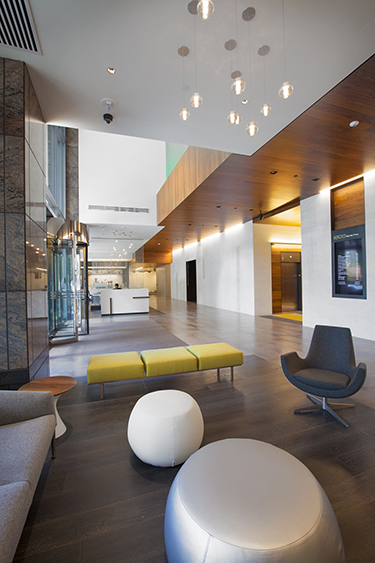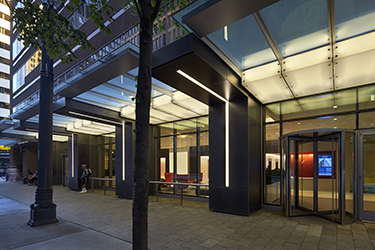|
Subscribe / Renew |
|
|
Contact Us |
|
| ► Subscribe to our Free Weekly Newsletter | |
| home | Welcome, sign in or click here to subscribe. | login |
Architecture & Engineering
| |
March 30, 2015
Architects, developers teach old buildings some new tricks
Journal Staff Reporter
Some older office buildings in Seattle and Bellevue have been getting lots of love lately.
Owners are installing new amenities and infrastructure, and fashioning better common spaces to help tenants attract workers in a competitive market.
In 2011, Talon Private Capital, a Seattle-based private equity company focused on real estate, and Prudential Real Estate Investors of New Jersey bought the 16-story 1800 Ninth in Seattle for $76.5 million. It has about 316,000 square feet, and two-thirds was vacant.
They renovated the 1990 structure and snagged Amazon.com as a tenant, which they couldn't have done without the revamp, said Bill Pollard, Talon cofounder and managing principal.
They sold the building for $150.38 million in late 2013, with it 97 percent occupied.
“I would say it was the lease with Amazon and the revamp that drove the price up,” Pollard said.
There are good deals out there on older office buildings in good locations, he said, and Talon and its institutional partners want to buy more. Some may not be gorgeous, but they can be updated, he said, which is cheaper than new construction.
Large companies in new office towers tend to put cafeterias or gyms in their spaces, he said, while the mid-sized firms Talon is going after prefer to share those costs in existing buildings and pay lower rent.
And there are far more of those firms than uber-large and small ones, Pollard said.
Changing older buildings requires finesse.
You must determine how to do the most good within your budget, and respect the original architecture, said Jennifer Thuma, a principal with Seattle-based LMN Architects.
“What you're doing is trying to pick your battles and figure out which pieces made the most sense to modify,” she said. “You don't — with these budgets — get to pull it all out and start over, which makes it more challenging.”
The revamps LMN is designing usually cost $5 million to $10 million, and Thuma said “we're seeing a good return for sure.”
Older buildings' systems need to be upgraded to handle more employees and their electronic devices. Thuma said the average space per employee today is 165 square feet.
What tenants want in common areas has also changed.
The lobby at 1800 Ninth was expanded and “speculatively planned” to attract a hip coffee shop (in this case Caffe Ladro) where tenants can work and socialize, said Thuma, whose firm was the designer.
For the 20-story office building 720 Olive in downtown Seattle, LMN is restyling the lobby into a greatroom-like space with a coffee/wine bar and a conference center/event space. The 305,000-square-foot building will also get a fitness center and bike storage/repair.
Talon and Prudential recently purchased 720 Olive, and renamed the 1979 high-rise Eighth + Olive.
U.S. Bank Centre in Seattle was built in 1989. Architects at Gensler are rethinking the retail and public spaces for the owners ADIA (Abu Dhabi Investment Authority) and Ivanhoe Cambridge.
The 44-story, 943,575-square-foot structure was built as a mall with an office building on top, said Chad Yoshinobu, a design principal in Gensler's Seattle office. That mall model does not work for today's workers, who want spaces where they can concentrate, collaborate and create community. In essence, he said, they want a “there there.”
Based on its workplace research, Gensler will remake the U.S. Bank Centre's public areas to provide spaces that give people choices, where they can have a loud conversation, hold a conference, focus quietly or eat. “We're a very mobile generation. We work everywhere,” Yoshinobu said.
Amenities such as fitness centers, lockers and showers, and a new conference center will be added. The retail and eateries will be revamped to encourage people to stay longer.
Yoshinobu said the building has six entrances but no real front door, so two renovated entries off Pike Street will be become the main entrances.
Architects and developers used to drive the design of office space, Pollard said. Now tenants do. They like lots of windows, areas to work and play, and collaborative spaces. “Columns are out and open is in,” he said. “Low ceilings are out and high ceilings are in.”
Workers also drive the location of the office.
Pollard said in the old days, “If you knew where (a company's) executive lived, you likely knew where the office space would be located. Now it's where (do) the employees live and want to be.”
Thuma said development of new office towers here has put pressure on older buildings to compete, and that means even small things matter.
“You don't necessarily get more rent when you change the graphics in the garage,” Thuma said, but things like that or a new name give it a fresh look.
Repositioning adds value, Yoshinobu said.
UBS Realty Investors owns Century Square, a 1986 office building in Seattle whose occupancy jumped 10 percentage points, to 92 percent, after an earlier Gensler-designed repositioning, he said.
Now Gensler is redoing the first floor eatery. “It wasn't a destination,” Yoshinobu said. “That was the problem.”
LMN did quite a bit of work on the 34-story 1111 Third Avenue building in Seattle. What had been a “dark and creepy” exterior arcade is now a bigger, lighter, more transparent lobby with new materials and lighting, Thuma said.
Corridors, elevator lobbies and restrooms were updated; a fitness center was added; and an entry was created to the adjacent Second & Spring Building so it shares 1111 Third's plaza. The buildings are part of a portfolio owned by Walton Street Capital, and Talon is the operating partner.
Seattle isn't getting all the love.
Gensler designed a makeover for Skyline Tower in Bellevue to attract tech tenants after Kilroy Realty bought it in 2012.
The 24-story, 416,800-square-foot tower was built in 1983.
“The building was tired,” said Yoshinobu. “It had dated pink granite. It had dark, stuffy wood all over the public space. The lighting levels were very bad.”
The new design gives the lobby the feel of a living room — a whimsical one with a two-story sculpture of red sticks.
The outdoor plaza was also made more inviting with new seating to entice workers in Skyline — and neighboring buildings. Food trucks set up there and workers mingle.
“What drives a lot of tech is the idea of community,” Yoshinobu said. “It's about being social — of having a place were everybody can gather.”
Occupancy jumped 12 percentage points after the repositioning, he said.
Also in Bellevue, Talon and Houston-based Lionstone Capital are working on Bellefield Office Park at Southeast Eighth and 112th Street, between the freeway and downtown. The owners want to attract tech firms that want to be near the urban core but still have an outdoor recreation area.
Talon and Lionstone recently bought the 53-acre campus for $120.3 million. It has 15 low-rise buildings with 510,000 square feet.
Thuma said office buildings that don't get up to speed could lose out.
“Will they go back to the acoustical ceiling tile corporate space? I doubt it,” she said.
Lynn Porter can be
reached by email or by phone
at (206) 622-8272.





